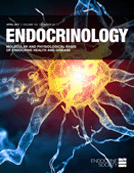-
Views
-
Cite
Cite
A. C. DELORME, J. L. DANAN, M. G. ACKER, M. A. RIPOCHE, H. MATHIEU, In Rat Uterus 17β-Estradiol Stimulates a Calcium-Binding Protein Similar to the Duodenal Vitamin D-Dependent Calcium-Binding Protein, Endocrinology, Volume 113, Issue 4, 1 October 1983, Pages 1340–1347, https://doi.org/10.1210/endo-113-4-1340
Close - Share Icon Share
A calcium-binding protein (CaBP) similar to rat duodenal vitamin D-dependent CaBP was identified in rat uterus. Uterine CaBP and duodenal CaBP had the same mol wt (9,000–10,000), exhibited the same calcium-dependent electrophoretic mobility, and were immunologically identical. The localization of CaBP in the rat uterus was explored using indirect immunoperoxidase methods, and by CaBP RIA in the endometrium and myometrium after enzyme separation. In the endometrium CaBP was found in the cytoplasm of the stroma cells but not in the epithelium or in the glandular cells. In the myometrium, it was located inside the smooth myometrial fibers. Hormonal regulation of CaBP was shown to differ in the uterus and duodenum. Duodenal CaBP concentrations increased in response to 1,25-dihydroxyvitamin D3 (1,25(OH)2D3), and were not influenced by ovariectomy or sex steroids administration. By contrast, CaBP synthesis fell drastically in the uterus of ovariectomized rats, but was greatly enhanced by low physiological doses of 17β-estradiol. This effect of 17β-estradiol on uterine CaBP was dose dependent. Medroxyprogesterone and more especially 1,25(OH)2D3 exerted no such stimulating effect on uterine CaBP. In vitamin D-deficient ovariectomized rats, administration of 17β-estradiol alone restored the uterine CaBP concentrations to normal and this potency contrasted with the apparent inability of 1,25(OH)2D3 to affect the uterine CaBP concentrations. Our data suggest that, unlike duodenal CaBP regulation, the expression of the CaBP gene in rat uterus is predominantly controlled by 17β-estradiol. (Endocrinology113: 1340, 1983)





